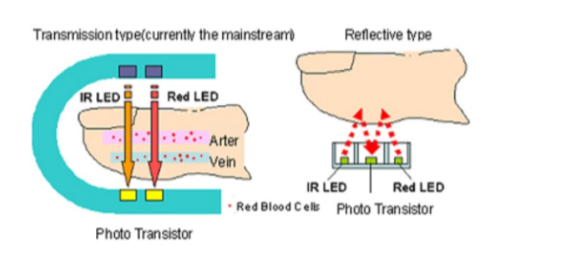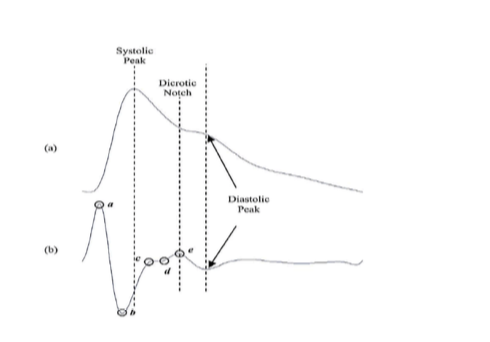The Basic Overview of the PPG Technology
Published:
The term PPG could be a bit of a new term for some of us, which stands for photoplethysmography. In most simple terms it can be identified as a light based technology which aims to identify the blood flow or the blood volume change in the human vascular system. Through detecting this variation, we could obtain PPG signals which can be identified as a form of a bio – signal generated within the human body. Normally the PPG signals are obtained from areas of the human body such as the fingertips, the earlobe or the toes where a concentration of blood vessels could be identified.

Picture Resource - http://www.ee.columbia.edu/~kinget/EE6350_S15/08_PPG1_Girish_Oliver/overview.html
The term ECG is quite a common term that we use in day to day life. Although we normally don’t know the technicality behind it, we know that it’s a form of signal where we can identify the persons cardio vascular activities. It is one of the most popular methods which is monitored for cardio vascular related diseases. Simply the ECG or the electrocardiography is obtained via the placement of electrodes on the person’s body and thus extracting the electrical signals which are generated.
It is important to compare the PPG and the ECG of a person. The PPG signal of a person can be identified as a much broader class of signals which focus on the entire vascular system of the human body compared to the ECG where the focus is solely on the cardio-vascular system. Since the PPG signal can focus on the entire vascular system the PPG of a user can be used for disease prediction for a broader class of diseases all over the body. These could vary from cardio-vascular, Diabetics, Kidney and other vascular related diseases. Hence in conclusion the PPG technology has a focus on the entire human body relative to ECG.
Although it should be noted that when the cardio-vascular diseases are concerned the ECG would give much more detailed analysis since its sole focus is on the cardio-vascular system. Hence for diagnosis of such diseases ECG would be much more appropriate. The ECG signal of the user can also be derived through the PPG signal. Where through taking the second derivative of the PPG signal the ECG like signal could be obtained.

Picture Resource - http://www.biomedres.info/biomedical-research/effect-of-source- wavelength-on-second-derivative-of-finger-photoplethysmogram-in-healthy-young-female- volunteers.html
The typical PPG signal of a user can be identified through Figure (a) where as the second derivative of the PPG signal is presented in Figure (b). The second derivative of the PPG signal is similar to the ECG signal.
I have experimented using the PPG technology with my friends Buddhishan Manamperi & Ahamed Ifham. We identified that one of the most accurate sensors in the market to obtain the PPG signal was the “Heart Rate Click” sensor by MikroElektronika which posses much more characteristics such as pulse oximetry. It is important to note that the Arduino libraries are readily available for these sensors where we can identify the Heart Rate, Temperature, Spo2 and the real time PPG signals of the user. The Sensor uses two LED’s a red and an infra red one, to measure the blood volume variations through detecting the wave length differences of the emitted and received optical waves. The sensor has in built noise cancelation and signal processing units to obtain accurate sensor readings.
Resources for the sensor used - https://shop.mikroe.com/click/sensors/heart-rate
Link to the Libraries - https://github.com/oxullo/Arduino-MAX30100
Pulse oximetry could be identified as a technique where the oxygen saturation of the human body can be measured. This can also be done via the PPG technology mentioned above. And it should be noted that it is being used widely in medical applications. In a practical sense you might have used mobile applications which are able to detect your pulse rate via the placement of your finger on top of the phone’s camera. It is the same technology which is used where the application focus on the basic PPG technology for such measurement.
There has been research conducted how the PPG technology can be improved. And in some instances people have used green LED’s compared to Red or Infrared which is supposed to enhance the accuracy. Thus a bit of reading and research need to be conducted in order to identify the affect of such parameters. Also there are other parameters such as motion artifacts which affect the sensor reading as well as ambient light artifacts which need to be minimized for accurate readings.
Hence in conclusion when we were trying to identify an easy method to obtain the basic ECG characteristics of a user we came across the PPG technology, which compared with the conventional electrode based methodologies is a quite easy methodology which is convenient and non invasive. Also we were able to identify researches conducted which focused on disease prediction via the analysis of the PPG signals. Hence it should be noted that PPG technology is broadly used for disease prediction in advance. We hope this article was able to provide a basic roundup on the PPG technology and that it would help in your further study of the PPG technology. Good Luck!
We found these resources for disease prediction via the PPG technology useful and inspiring.
- Gilaberte, Sonia, et al. “Heart and respiratory rate detection on a bathroom scale based on the ballistocardiogram and the continuous wavelet transform.” Engineering in Medicine and Biology Society
- (EMBC), 2010 Annual International Conference of the IEEE. IEEE, 2010.
- Xing, Xiaoman, and Mingshan Sun. “Optical blood pressure estimation with photoplethysmography and


